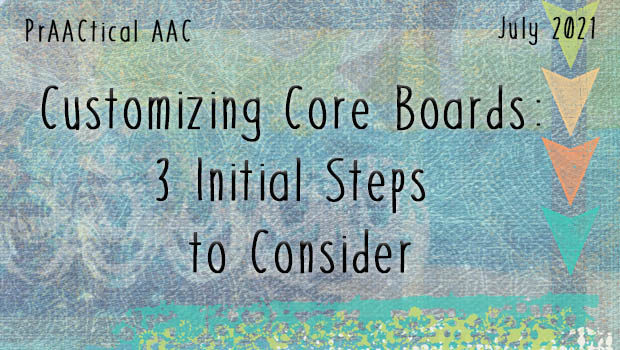Customizing Core Boards: 3 Initial Steps to Consider

Core boards have gained popularity as an on-ramp to AAC in classrooms and therapy centers, and can be a valuable way to bolster implementation in those settings. AAC users need and deserve to use communication tools that reflect their individuality, though, so these are generally seen as a stepping stone to an approach that uses assessment data to make AT decisions.
In the meantime, how can we ensure that the core boards we use are functional for the complex AAC learners we serve? Here are three areas to consider addressing.
- Vision: If the AAC learner has visual difficulties, it’s important to determine what changes need to be made so that they can see and use the core board. In collaboration with a vision specialist who knows the AAC learner’s needs and abilities, the team should consider things like:
- The size of the individual symbols and words,
- Optimizing color and contrast,
- Complexity and size of the full array,
- The role of lighting in the environment,
- Whether to use or avoid lamination or other things that can create glare, and,
- Use of specific background colors and borders.
- Access: AAC learners with significant motor challenges may not be able to accurately point to symbols on a core board and will require individualization and, perhaps, some form of alternative access. The input of OTs and PTs who know the individual can provide guidance on things like:
- Selecting and using pointing aids,
- Identifying optimal seating and positioning, and,
- Determining methods for alternative access (e.g., Partner Assisted Scanning). When alternative access is used, it’s critical that both the learner and communication partners have sufficient training on the operational aspects of these strategies.
- Symbol Type and Layout: There are several symbol sets/systems and layouts for core boards. Some are offered for free by AAC manufacturers/app developers, and others are created by individual professionals. If the end goal is for the AAC learner to eventually have a fully customized AAC system that includes technology selected through a feature match process, then the team may want to consider core boards with features that align with some of SGDs and AAC apps.
There are many other areas to consider for customizing core boards for AAC users, but these three areas are among the first things to address. Do you have strategies for ensuring that core boards are appropriate for the needs of the individual AAC learners in your life? We’d love to hear about them.
Filed under: Featured Posts, PrAACtical Thinking
This post was written by Carole Zangari
